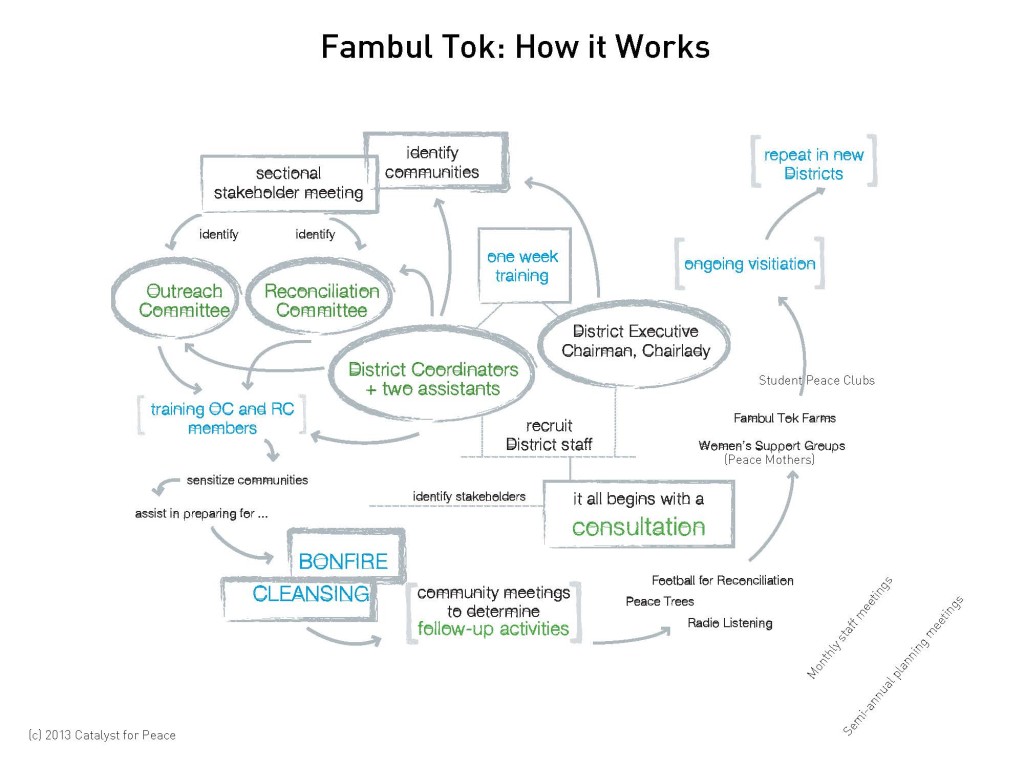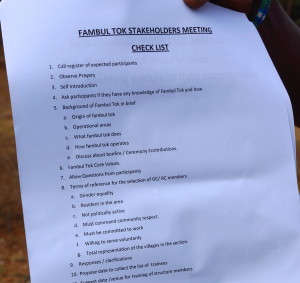Fambul Tok in Sierra Leone has pioneered a large scale, but fully locally-owned and led post war reconciliation and community building process. The key to local local ownership is in the PROCESS Fambul Tok uses facilitate community agency, collective decision making, and collective action.
So – how exactly does that process work?
 Download our How It Works chart here [PDF].
Download our How It Works chart here [PDF].
The first step of any Fambul Tok process is a consultation. Sierra Leone has 14 districts, similar to states or provinces, around which Fambul Tok organizes its work. The Fambul Tok national staff gathers a wide range of stakeholders (male and female) from each chiefdom in the district to discuss whether communities are ready to reconcile and if so, how they want to go about it.
When ready to go forward, the group elects a District Executive (DE), an all-volunteer group drawn from across the district that will oversee the Fambul Tok program, with equal numbers of men and women. A District Coordinator (DC) and two or three other staff from the district are recruited as staff to serve as the coordinators and engine for the process, working in close partnership with the District Executive. The district staff and executive receive extensive training in the Fambul Tok values and process, as well as in reconciliation, mediation, and trauma healing.
A series of initial sectional meetings leads to identifying the communities most ready to engage in Fambul Tok. They begin working immediately at the very local “sectional” level. A section is a collection of usually 5 to 10 villages.
 Once a section is identified, the DC and DE host a stakeholders meeting with elders (male and female) from the section, to explain the Fambul Tok approach and values and confirm that they want to engage it. The staff then works asks this group to identify Outreach Committee (OC) members from their section: local youth and other community members who can serve as the chief community educators about Fambul Tok. Reconciliation Committee (RC) members are also identified at the sectional level, representing a cross section of community leaders, including imams, priests, Mommy Queens (women leaders), and youth leaders, etc. Again, having equal numbers of men and women is emphasized, as is the credibility these people have among their community members. The RC can help mediate conflicts that might arise throughout the process, or provide special support and guidance to their community members as they work through the unhealed wounds of the war.
Once a section is identified, the DC and DE host a stakeholders meeting with elders (male and female) from the section, to explain the Fambul Tok approach and values and confirm that they want to engage it. The staff then works asks this group to identify Outreach Committee (OC) members from their section: local youth and other community members who can serve as the chief community educators about Fambul Tok. Reconciliation Committee (RC) members are also identified at the sectional level, representing a cross section of community leaders, including imams, priests, Mommy Queens (women leaders), and youth leaders, etc. Again, having equal numbers of men and women is emphasized, as is the credibility these people have among their community members. The RC can help mediate conflicts that might arise throughout the process, or provide special support and guidance to their community members as they work through the unhealed wounds of the war.
Both OC and RC members receive training, and then they begin the work of sensitizing the villages in the section and assisting them in preparing for the bonfire and cleansing ceremonies.

After the ceremonies, national and district staff meet with the communities to determine the follow-up activities they want to pursue, including establishing peace trees as a gathering spot and a space for addressing conflicts and challenges as they arise in the future; forming radio listening clubs to continue to share stories of reconciliation; holding football “peace matches”; establishing Peace Mothers groups; planting community farms; and establishing school clubs programs.


Throughout these follow-up activities, district and national support staff continue to visit the communities to check in with how the reconciliation process is going and provide support as needed.
The cycle is repeated in each new section, and the overall model is repeated in each new district.
All of Fambul Tok’s work in the communities and districts is supported by a strong national staff that has it’s own cycle of support and learning. Critical in this support cycle are monthly staff meetings, where the staff comes together to share stories, lessons, challenges, and new ideas. And fun. Unstructured time together is critical support for the staff, especially since many of the stories they hear can be unspeakably difficult.
A biennial program review with time for staff capacity deepening—typically including one meeting for the senior staff in the US, away from the frontlines of the work and with opportunity for truly big picture reflection and re-visioning—completes the cycle, supporting a strong and responsive program and a strong and resilient organizational infrastructure.
Blog banner image (c) Sara Terry for Catalyst for Peace. All other photos by Libby Hoffman

